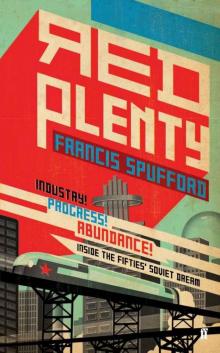- Home
- Francis Spufford
Backroom Boys
Backroom Boys Read online
Further praise for Backroom Boys:
‘Few books have begun to explain the profound changes that Britain has experienced in the past thirty years; this is an enjoyable and illuminating exception … [Spufford’s] six forensically researched and grippingly told tales of our times argue against the idea that when the factories and pits and shipyards closed, so did a certain kind of national self-ideal: that of home-made ingenuity and understated scientific brilliance.’ Observer
‘This is the most fascinating book I’ve read all year … The author Francis Spufford has a marvellous combination of gifts – a deep passion for his subject, an engaging way with prose and a wonderful ability to explain elaborate concepts without erring into triviality.’ Daily Mail
‘Spufford writes with great verve and great skill … The style is reminiscent of Tom Wolfe’s classic The Right Stuff.’ Spectator
‘Inspiring stuff … This is first-class writing about the work of the scientists and technologists popularly supposed to wear pullovers and quizzical expressions, smoke pipes and do something incomprehensible in small back rooms.’ New Scientist
‘Terrific, an unlikely but compelling tribute to unsung ingenuity, as elegantly composed as the computer code it describes … The reader will share [Spufford’s] delight in settling down next to a roaring fire with these men – and discovering that they do indeed wear jumpers and talk of colleagues as “chaps”.’ Financial Times
‘With Backroom Boys, Spufford has claimed an unlikely niche as the Bruce Chatwin of applied science.’ The Times
‘Spufford’s wonderful Backroom Boys – a celebration of post-war British engineering which, like all the best pop-science, seeks not just to heal any lingering Two Cultures rift, but to promote a broader understanding of what Spufford calls “the shared material world we inhabit”.’ Time Out
Backroom Boys
The Secret Return of the British Boffin
FRANCIS SPUFFORD
In memory of my grandfather, L. M. Clark, Sc. D 1897–1953
Industrial chemist
Contents
Title Page
Dedication
Epigraph
Preface
1 Flying Spitfires to Other Planets
2 Faster than a Speeding Bullet
3 The Universe in a Bottle
4 The Isle Is Full of Noises
5 The Gift
6 The Art of Falling
Epilogue
Acknowledgements
Sources & Further Reading
Index
About the Author
Copyright
‘Kings, warriors, and statesmen have heretofore monopolised not only the pages of history, but almost those of biography. Surely some niche ought to be found for the Mechanic, without whose labour and skill society, as it is, could not exist. I do not begrudge destructive heroes their fame, but the constructive ones ought not to be forgotten; and there IS a heroism of skill and toil belonging to the latter class, worthy of as grateful record, – less perilous and romantic, it may be, than that of the other, but not less full of the results of human energy, bravery, and character.’
Samuel Smiles, Industrial Biography, 1863
Preface
‘The backroom boys’ is a phrase from the 1940s. It’s what industrial-age Britain used to call the ingenious engineers who occupied the draughty buildings at the edge of factory grounds and invented the technologies of the future. Almost always, they were boys, or rather men: for historical reasons, but also because there is perhaps an affinity between the narrow-focused, wordless concentration required for engineering and a particular kind of male mind. Black-and-white war films made them iconic, gave them a public face everybody recognised, as the unworldly innocents who somehow produced a stream of spectacularly lethal gadgets. ‘The backroom boys have come up with this. Perhaps you’d like to explain, Dr Prendergast.’ ‘Certainly, Major. You twist this little dial here, breaking the mercury-fulminate fuse, and you gently lower this lever here, and a sheet of flame comes out there. Oh, I am sorry. I’m sure your moustache will grow back.’ In the cinema, real backroom boys like Barnes Wallis, creator of the bouncing bomb, and R. J. Mitchell, designer of the Spitfire, were joined by a legion of fictional counterparts. The public learned a set of characteristics that apparently spelled boffin: distracted demeanour, ineptitude at human relationships, perpetual surprise at the use that other people put their ideas to. But the backroom boys didn’t only do military technology. They existed in every industry. They worked on the chemistry of paint, they devised new relays for telephone exchanges, they improved the performance of knitting machines. They were the quiet makers, regarded with affectionate incomprehension (and a little condescension) by a nation which found it easier to admire its smooth talkers and nice movers.
This book begins in the 1940s, but it is about much more recent British history. It is about what happened to the backroom boys as the world of the aircraft factories and the steel mills faded. There is an expected story here, a story we all know already about decline and the diminishing of British ambitions, but like the stereotype of the backroom boys, that story gives a complacent pat to a process which was, in truth, much less predictable. It’s true that there were errors, there were losses, there was a retreat from industrial competence out of all proportion with necessity. But there were unremembered victories as well as unforgotten failures. Above all, there was adaptation. When the old industries faltered in Britain, the ingenious spirit of the backroom boys survived. The urge to build the future detached itself from lathes and wind tunnels, and reappeared in the new technologies of software, gene sequencing and wireless communications. The backroom boys are with us still.
This book is about the makers, but it’s also about the making. Engineering, of any description, is an art of the possible. It happens at the junction between what is materially possible and what is humanly possible. Its course is shaped by the latest developments in the endless struggle to manipulate obdurate matter, and also by the agendas and priorities and resources and hopes and illusions of a society. Engineering is where science intersects with the way we live. So the fortunes of governments and businesses belong in its story; they have to be told too.
All the events described here really happened, but I am not trying to write the whole history of the transformation that took place in Britain over the last thirty years. I have not set out to be comprehensive, or final. I have chosen six incidents in the process, six scenes in a much larger drama. But, taken together, they tell one story: the story of how Britain stopped being an industrial society, and turned into something else.
One
Flying Spitfires to Other Planets
In November 1944, a group of men met in a London pub. They were engulfed by the cosy gloom of that late-Victorian moment when the clock stopped on the style of British drinking places; with an extra layer to the gloom in this fifth year of the war, less cosy. Dinginess had settled in too. London was dog-eared, clapped-out, frankly grimy. Though Britain had not shaken off its usual inefficiencies at mass production, it had converted its economy to the needs of the war more completely than any other combatant. For five years there had been no new prams, trams, lawnmowers, streetlamps, paint or wallpaper, and it showed. All over the city things leaked, flapped, wobbled and smelt of cabbage. It was the metropole that Orwell would project forward in time as the London of 1984.
But these drinkers were not the kind of people to let an unpromising present determine the shape of things to come. They were the inner circle of the British Interplanetary Society, and in 1938 they had published a plan for reaching the moon using two modules, one to orbit, one to descend to the lunar surface. Since they calculated the plan might cost as much as a million
pounds to carry out, they obviously could not build the rocket it called for. They could only have a go at a couple of the spacecraft’s instruments. ‘We were in the position of someone who could not afford a car, but had enough for the speedometer and the rear-view mirror,’ Arthur C. Clarke would remember later. So they constructed a ‘coelostat’, a device to stabilise the image of a spinning star-field. It was made from four mirrors and the motor of Clarke’s gramophone; it worked, and it was proudly displayed in the Science Museum.
The Society had suspended itself for the duration of hostilities, while the members scattered to work in radar and aeroplane design. Now they were meeting again to talk about postwar activities. In particular, they wanted to hear what one of them, Valentine Cleaver, had gleaned about the state of play in rocket research on his recent journey to America. Well, said Val Cleaver incredulously, he had been assured that with present technology it was completely impossible to build a rocket of any size. The rumours of big German rockets were just propaganda. At about that moment 300 km to the east a twelve-tonne missile designed by a former member of the BIS’s German sister society, the Verein für Raumschiffahrt, left the ground carrying a one-tonne high explosive warhead. The party in the pub shook their heads over the technological defeatism of the Americans: the missile rose out of the earth’s atmosphere, steered by four graphite rudders in its slipstream. One hundred kilometres up, it reached the top of an arc as neat as the illustration of a parabola in a geometry textbook.
You have to pause for a moment there, as the rocket’s vertical movement paused, with the forces of lift and of gravity briefly equalised, and contemplate the strangeness of the place it was in, a human-made object hurled outside the sphere in which the whole of human history had taken place. The war, and all previous wars, and all previous peace, lay under the starlit cloud-systems that stretched away to the curve of the planet’s edge, where the glitter of tomorrow’s sunlight brightened the rim. Then the rocket accelerated down from space into the whorl of cloud over the Thames estuary to confirm London’s founder membership in the small club of cities which have been attacked by ballistic missiles. London, Antwerp, Paris, Tehran, Tel Aviv, Baghdad, a few others: that’s all. If the rocket had been loaded with the nuclear weapon that would justify the expense of the delivery system to military planners in the decades to come, it would have fried the city from Kensington to Bermondsey. As it was, it caused only a fraction of the deaths required to amortise the production costs. In terms of deaths per reichsmark, it was considerably less lethal than a handgun. It only flattened a street – not that that was much comfort to those beneath the particular roof it burst through faster than the speed of sound.
The explosion shook the pub. Fine plaster dust settled onto heads and shoulders – the invariable dandruff of air raids. Unlike other people, though, Cleaver and Clarke and co. knew immediately how to interpret the blast that had happened suddenly, without the sound of bombers overhead, and even more revealing, the strange rising boom afterwards, as air rushed in to fill the tube of vacuum the rocket had drilled down the sky. They knew what messenger of the future had just burst into the Dickensian darkness of the saloon. This was not the first V2 to hit London: the government had been covering up the attacks with stories of exploding gas mains for a little while, and already scientists from the Royal Aircraft Establishment were secretly collecting twisted fragments of Wernher von Braun’s precision engineering and trying to put the shattered jigsaw back together in a Farnborough hangar. But this was certainly the first V2 to be greeted at the receiving end with laughter and excitement. The BIS rose to their feet and cheered.
The roots of the Space Age in weaponry are well known. So is the selective amorality of technologists, who judge the world with the same scruples as other men and women except in the one area of their specialism, where means and ends are divorced from each other, and in the passion to make their project work all other questions are temporarily suspended. What isn’t familiar any more is the local, British embodiment of the Space Age. In the 1980s and 1990s, Britain was so allergic to rockets, so minimally involved in the European Space Agency, that it’s hard to imagine that it was ever any different. But from the 1950s to 1971 Britain had a space programme – of a sort, in a small way. In the geography of the Space Age, Cape Canaveral and the Baikonur Cosmodrome were joined for a while by the faint presence of Woomera, on the Nullarbor Plain in South Australia, with its concrete Anglican church (St Barbara’s) and its three messes for different grades of rocketmen. Big rocket motors were test-fired at Spadeadam in Cumbria; polite MOD policemen would step out of the heath and turn you back if you tried to motor towards the installation on days when the ground was shaking. Smaller engines filled the air with the sound of ripping linen, titanically magnified, at a converted gun emplacement on the coast of the Isle of Wight. Men in tweed jackets with leather elbow patches sat in control rooms watching bakelite consoles. The countdown was heard in regional accents.
The BIS had assumed, in 1944, that the technological resources which were helping Britain win the war would be directed, in due course, towards rockets and space. The same great-power military-industrial complex that had produced radar and the Spitfire would carry through the BIS’s dreams into earth orbit and beyond. They had the tunnel vision of the engineer, with its exclusive focus on what is technically possible; but for a while their dreams did make halting progress into reality. In the end, of course, it was lack of money that stopped British rockets. Wernher von Braun had been correct in the essentials when he and his senior staff at Peenemünde decided to surrender to the Americans; the Americans because, he said, ‘we feared the Russians, we despised the French, and the British could not afford us’. But the shortage of money in British rocketry had more effects than the obvious ones, some even positive; and behind the expected story of Britain’s decline as an industrial power, which dominated the minds of policymakers and fixed their sense of realistic goals, there was another story, of a success that has sunk into oblivion.
*
After the war, the British Army evaluated a few captured V2s in a test code-named Operation Backfire. ‘For the sake of their very existence, Britain and the United States must be masters of this weapon of the future,’ concluded the officer in charge, Major-General A. M. Cameron. But by the criteria of conventional artillery, the V2s had been found hopelessly inaccurate, an impression that was only confirmed when intelligence analysts sifting captured German documents discovered that there had been a V2 campaign against the port town of Lowestoft. Since every missile either fell into the sea or landed, dud, in muddy East Anglian fields, no one at the time had noticed that the town was under ballistic bombardment. A weapon your enemies did not notice when you used it against them might be the weapon of the future, but was probably not ready to become a weapon of the present. Better leave it until someone worked out how to deliver a rocket to a precise map reference, or until it mattered less if ground zero was a mile or two from where you wanted it to be.
The decision by the Attlee government in 1947 to develop a British A-bomb transformed the numbers. The first delivery system commissioned for the British deterrent was the RAF’s ‘V’ family of jet bombers – strange revenants when you see one now in an aircraft museum, the delta-winged shape familiar in modern stealth aircraft filled out with 1950s materials and pre-transistor avionics; coarsely, prodigally powerful, like an adding machine wired to a nuclear power station. Gradually, it was decided that the next generation of the deterrent after the V-bombers should be an all-missile system. In 1954, Britain signed an agreement with the US to start a joint programme of missile research. At this point, there was no technology gap, because the hugely different resources of the two countries had not yet begun to produce their hugely different results. The Truman administration was eager to spread the costs of rocketry, and to deny a few expensive titbits at least to the ever-hungry American aerospace contractors; on the British side, the Conservative government in its pre-Suez min
dset still assumed that Britain would play a large role in the world’s future, and hence in the weapon of the future.
Britain’s share in the NATO arsenal was to be an IRBM, an intermediate range ballistic missile, named Blue Streak. Rocketdyne of the United States passed the specs of their Atlas rocket motor to Rolls-Royce, where a group of engineers under Val Cleaver of the BIS set to work modifying and refining it. The job of constructing Blue Streak’s body went to the De Havilland aircraft company of Stevenage. They created a shining stainless-steel fuselage, attractively ridged fore and aft: they had, after all, a reputation for beautiful aeroplanes to maintain, and if someone commissioned a nuclear missile from De Havilland, they would get one obeying the minimalist aesthetics of a Navajo blanket or a Shaker armchair. They would not, however, get it very quickly. By the spring of 1960, £60 million had been spent, a further £240 million were needed to complete the design, and £200 million again on top of that would be required to actually produce the missiles and to install them in their deep silos in East Anglia. The Russians had put Sputnik into orbit, but there was no suggestion that Blue Streak represented any kind of investment in the possibilities of space. Like all ballistic missiles since the V2, it was designed to loop out of the earth’s atmosphere on its way to the target. Like all ballistic missiles, it therefore had potential as a satellite launcher, but the money devoted to it was military spending, the traditional, calculated destruction of blood and treasure. Treasure now, blood if Blue Streak ever melted Omsk into a puddle of radioactive glass. There was only the acknowledgement that one day rockets might be good for other things. Duncan Sandys, the Defence Minister, wrote a secret memorandum in 1958:

 Light Perpetual
Light Perpetual True Stories
True Stories The Child that Books Built
The Child that Books Built Golden Hill
Golden Hill Unapologetic
Unapologetic Red Plenty
Red Plenty Backroom Boys
Backroom Boys